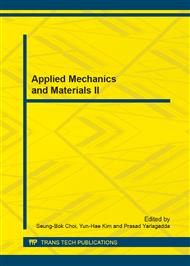p.509
p.514
p.519
p.524
p.531
p.535
p.539
p.543
p.547
Hydro-Mechanical Coupled Analysis of the Variable Permeability Coefficient of Fractured Rock Mass
Abstract:
Based on the fluid-solid coupling theory, we describe the fractured rock mass as a continuous porous medium and consider the rock mass permeability coefficient a function of the stress and strain. By using the multi-physics coupling analysis software COMSOL, we achieved the dynamic change of permeability coefficient, and found that serious damage due to micro cracking occurred in the excavated damage zone of rock mass due to the yield and failure of rock mass. Corrodingly, permeability will remarkably increase, which is basically consistent with the experimental results. The simulations indicated the "indirect coupling" effect of seepage and stress. Therefore, the coupled analysis of the seepage and stress in fractured rock masses is important for the practical rock mechanics and rock engineering.
Info:
Periodical:
Pages:
531-534
Citation:
Online since:
December 2013
Authors:
Price:
Сopyright:
© 2014 Trans Tech Publications Ltd. All Rights Reserved
Share:
Citation:


